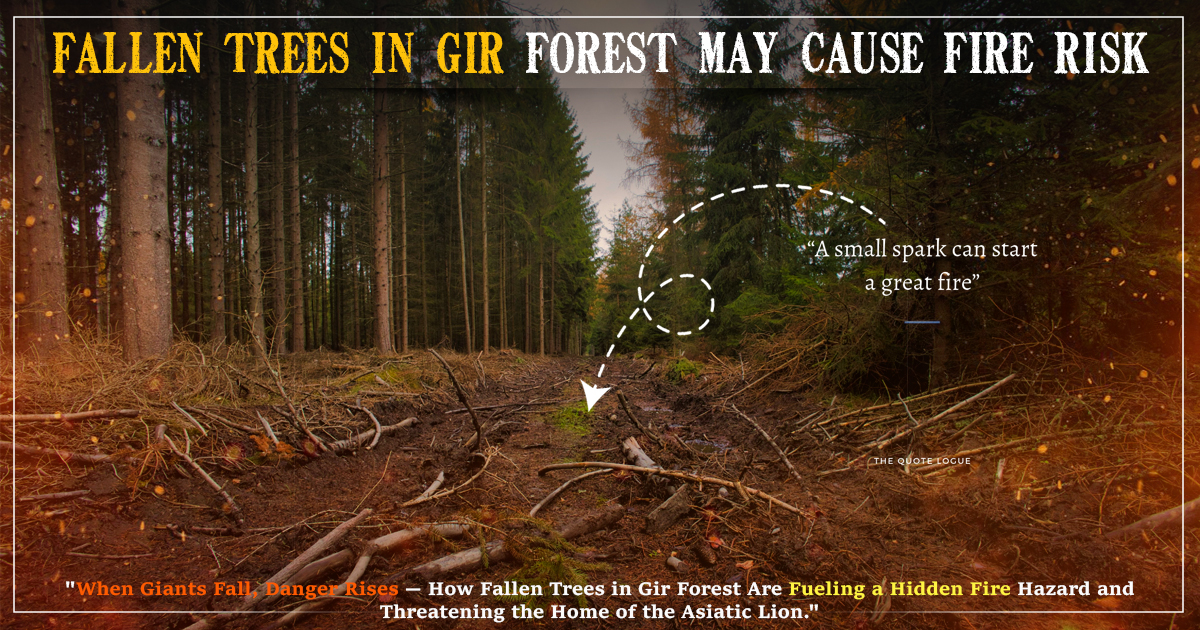Fallen Trees In Gir Forest May Cause Fire Risk
Gir National Park
Gir online booking
- Author : Adeeb Sahil
- Date : August 07, 2025
Gir National Park is located in Gujarat, on the western side of India. This forest is very important because it is the only place in the world with wild Asiatic lions. In the past, these lions used to inhabit many places in India and the Middle East, but that has changed. Now these lions live only in Gir National Park.
This article talks about a serious problem in this forest. Many trees fell down after a big storm. These trees have not been removed. Now they have become dry and can catch fire easily. That is a potential danger to both the forest and its inhabitants, particularly lions. The issue needs immediate action so that the wildlife and the forest can remain safe. Furthermore, many tourists make Gir online bookings for safaris every year, so it is important to protect this area.
About Cyclone Tauktae
Cyclone Tauktae was a very strong and dangerous storm. It hit some Indian states near the sea in May 2021. Gujarat was one of those states. This heavy storm caused a lot of damage in Gir.
According to reports, around 3.3 million trees were uprooted or broken in Gir Forest during the cyclone. Most of these trees were big and native to the area. Some of them were teak trees, which are an important part of the forest. These trees helped make the forest healthy and strong.
Later, during a meeting of the National Board for Wildlife (NBWL), this topic was discussed. But in the written record of that meeting, the year of the cyclone was written as 2023 instead of 2021. This mistake caused some confusion.
Current Problem
As of the year 2025, there are still around 86,969 trees lying on the ground in Gir National Park. These fallen trees are found in two districts: Junagadh and Gir Somnath. Since they have been lying there for almost four years, the wood has become very dry.
Dry wood can catch fire very easily. In the hot summer months, the forest becomes dry, and even a small spark can start a big fire. This fire can come from nature, or it can happen because of human actions.
If a fire starts, it can destroy plants and trees in the forest. It can also put the lions and other animals in great danger. Most of the dead trees are found in the areas where animals live. Since the wood is from dry trees like teak and other native species, it makes the fire risk even worse. These types of trees burn very easily when they are dry.
What Experts Said In The NBWL Meeting
In March 2025, the NBWL held its 82nd Standing Committee meeting. In this meeting, many experts and members talked about the fire danger in Gir Forest. One of the members, H.S. Singh, said that the dead trees should be removed as soon as possible. He explained that if they are not removed, they can cause large fires.
However, experts also said that the removal must be done in a careful and correct way. They gave a few important rules to follow during the process:
- Only dead trees that are already down on the ground are to be removed.
- Forest officers must watch and control the removal work to make sure nothing goes wrong.
- No standing trees should be cut down while removing the fallen ones.
- The wood should be taken out using proper forest roads to avoid harming the environment.
These steps are very important. They will make sure that the forest is protected while solving the problem.
Plan By The State Government
The state of Gujarat and the local government have developed a strategy to remove dead trees. The plan says that the wood from these trees should be collected and sold. The money earned from this will be used to help lions and improve their forest home. This money will go to the Asiatic Lion Conservation Society, which works to protect lions.
But the government cannot start this work freely. The Supreme Court of India has to give final permission first. Until that happens, all the wood removed from the forest will be kept in a safe storage place called a forest depot.
No company or person will be allowed to use or sell the wood until all the legal and environmental rules are followed. If this plan is done correctly, it can be a good example. It will show how fallen trees can be used to help protect animals and nature.
Fire Risk In Lion Habitat
The areas where lions live have dry grass, leaves, and fallen wood. This material can catch fire very fast. In the dry season, even a small fire can spread quickly. The areas that are most at risk are grasslands and parts of the forest with trees that lose leaves in summer. These are the places where lions often walk, rest, or hunt.
If a fire happens, it will not only burn the plants but also harm animals. Lions, leopards, deer, and smaller animals can all get hurt or killed. Fire can also scare animals and make them run, which may cause them to leave safe areas.
Big fallen trees can also fall again or break into pieces and block the paths that animals use. This makes it harder for them to escape a fire. That is why stopping fires in lion areas is important.
Also, more tourists will feel safe visiting the forest if fire risks are reduced. This can also help promote Gir online booking for safari, which supports eco-tourism and brings awareness about lion conservation.
Past Cyclone Comparison
This is not the first time Gir National Park has sustained damage due to a cyclone. In 1983, another big storm came. It uprooted about 2.8 million trees. That was also a major problem. But Cyclone Tauktae in 2021 caused even more damage.
The 2021 cyclone was stronger, and the number of trees it destroyed was larger. This shows that the Gir Forest is now facing more powerful natural disasters. One reason for this may be changes in the world’s weather and climate. These storms are becoming more common and more dangerous.
Because of this, it is now more important than ever to take care of the forest. With every new storm, the forest becomes weaker. Animals like lions become more at risk. If no action is taken, it will become harder to protect them in the future. That is why good planning and forest care are needed right now.






(0) Comments: